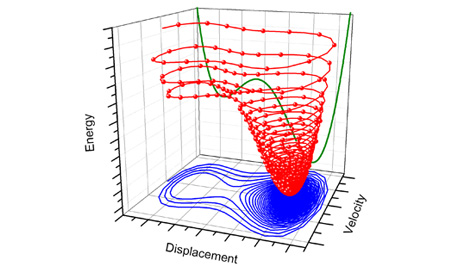Home > Press > Yale engineers bring new meaning to the force of light
 |
| Yale University engineers recently demonstrated that nanomechanical resonators can operate at much higher amplitudes than previously thought. The results represent an advance in optomechanics, in which the force of light is used to control mechanical devices, and could have implications for future communications and sensing technologies. |
Abstract:
New research by engineers at the Yale School of Engineering & Applied Science demonstrates that nanomechanical resonators can operate at much higher amplitudes than previously thought. The results represent an advance in optomechanics, in which the force of light is used to control mechanical devices. The findings could have implications for future communications and sensing technologies.
Yale engineers bring new meaning to the force of light
New Haven, CT | Posted on October 25th, 2011"We can flip a tiny switch with light," said Hong Tang, associate professor of electrical engineering at Yale and the principal investigator of a new paper appearing online Oct. 23 in the journal Nature Nanotechnology.
Amplitude refers to vibration range. Achieving high-amplitudes in traditional nanoscale mechanical systems has proven difficult because reducing a resonator's dimensions generally limits how much the resonator can move. Tang's team shows a way of overcoming the performance limitations of conventional systems.
The operating principle is similar to the laser cooling technique used in atomic physics. "One can control the motion of a mechanical structure, amplify or cool its vibrations, just by controlling the wavelength of laser light," said Mahmood Bagheri, the postdoctoral associate in Tang's lab who is the paper's lead author.
Tang and his research team also demonstrate in the paper that a tiny silicon structure within an optomechanical system can effectively store information without the aid of steady power supply — thus serving as a mechanical memory device.
Among other benefits, optomechancial memory devices can withstand harsher environments than electronic or magnetic memory devices, without losing data. Future technologies containing similar high-amplitude optomechanical resonators might be less sensitive to environmental conditions, such as variations in temperature and radiation. At the same time, high-amplitude resonators might enable more accurate and robust measuring devices.
The paper's co-authors are Menno Poot, Mo Li and Wolfram P. H. Pernice, all of Yale. The work was supported by the Defense Advanced Research Projects Agency. Tang is a past winner of a National Science Foundation CAREER award and of a Packard fellowship for promising young faculty members. Discover magazine featured him in its "100 Top Stories of 2009" issue for earlier work on the use of light force. He joined Yale's School of Engineering & Applied Science in 2006.
####
For more information, please click here
Contacts:
Yale University
Office of Public Affairs
& Communications
2 Whitney Avenue, Suite 330
New Haven, CT 06510, USA
Directions to Yale | Map
Phone, Fax, Email
Phone: (203) 432-1345
Fax: (203) 432-1323
Eric Gershon
203-432-8555
Copyright © Yale University
If you have a comment, please Contact us.Issuers of news releases, not 7th Wave, Inc. or Nanotechnology Now, are solely responsible for the accuracy of the content.
| Related News Press |
News and information
![]() Researchers develop molecular qubits that communicate at telecom frequencies October 3rd, 2025
Researchers develop molecular qubits that communicate at telecom frequencies October 3rd, 2025
![]() Next-generation quantum communication October 3rd, 2025
Next-generation quantum communication October 3rd, 2025
![]() "Nanoreactor" cage uses visible light for catalytic and ultra-selective cross-cycloadditions October 3rd, 2025
"Nanoreactor" cage uses visible light for catalytic and ultra-selective cross-cycloadditions October 3rd, 2025
Discoveries
![]() Researchers develop molecular qubits that communicate at telecom frequencies October 3rd, 2025
Researchers develop molecular qubits that communicate at telecom frequencies October 3rd, 2025
![]() Next-generation quantum communication October 3rd, 2025
Next-generation quantum communication October 3rd, 2025
![]() "Nanoreactor" cage uses visible light for catalytic and ultra-selective cross-cycloadditions October 3rd, 2025
"Nanoreactor" cage uses visible light for catalytic and ultra-selective cross-cycloadditions October 3rd, 2025
Announcements
![]() Rice membrane extracts lithium from brines with greater speed, less waste October 3rd, 2025
Rice membrane extracts lithium from brines with greater speed, less waste October 3rd, 2025
![]() Researchers develop molecular qubits that communicate at telecom frequencies October 3rd, 2025
Researchers develop molecular qubits that communicate at telecom frequencies October 3rd, 2025
![]() Next-generation quantum communication October 3rd, 2025
Next-generation quantum communication October 3rd, 2025
![]() "Nanoreactor" cage uses visible light for catalytic and ultra-selective cross-cycloadditions October 3rd, 2025
"Nanoreactor" cage uses visible light for catalytic and ultra-selective cross-cycloadditions October 3rd, 2025
Photonics/Optics/Lasers
![]() ICFO researchers overcome long-standing bottleneck in single photon detection with twisted 2D materials August 8th, 2025
ICFO researchers overcome long-standing bottleneck in single photon detection with twisted 2D materials August 8th, 2025
![]() Institute for Nanoscience hosts annual proposal planning meeting May 16th, 2025
Institute for Nanoscience hosts annual proposal planning meeting May 16th, 2025
|
|
||
|
|
||
| The latest news from around the world, FREE | ||
|
|
||
|
|
||
| Premium Products | ||
|
|
||
|
Only the news you want to read!
Learn More |
||
|
|
||
|
Full-service, expert consulting
Learn More |
||
|
|
||








